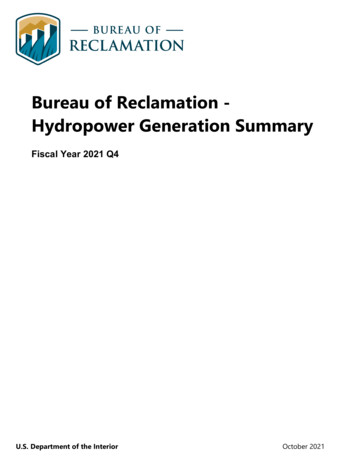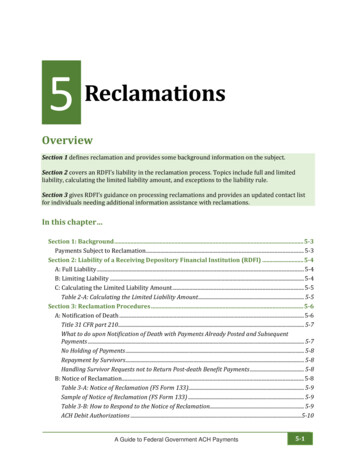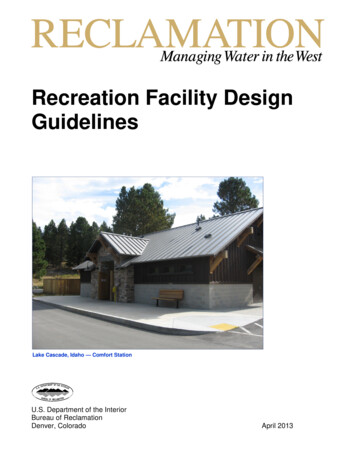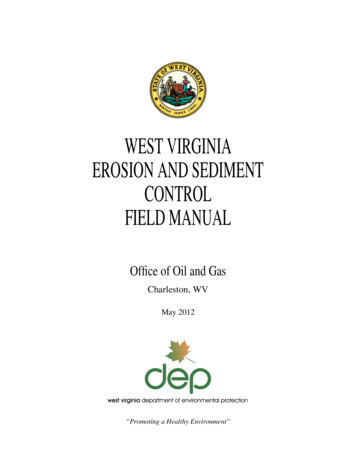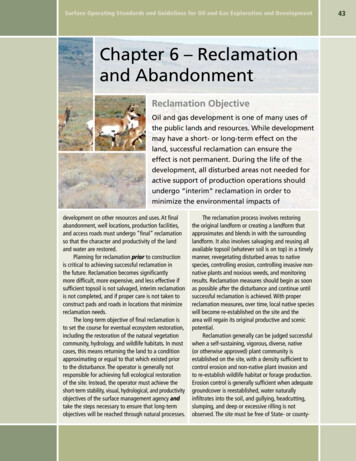
Transcription
Surface Operating Standards and Guidelines for Oil and Gas Exploration and DevelopmentChapter 6 – Reclamationand AbandonmentReclamation ObjectiveOil and gas development is one of many uses ofthe public lands and resources. While developmentmay have a short- or long-term effect on theland, successful reclamation can ensure theeffect is not permanent. During the life of thedevelopment, all disturbed areas not needed foractive support of production operations shouldundergo “interim” reclamation in order tominimize the environmental impacts ofdevelopment on other resources and uses. At finalabandonment, well locations, production facilities,and access roads must undergo “final” reclamationso that the character and productivity of the landand water are restored.Planning for reclamation prior to constructionis critical to achieving successful reclamation inthe future. Reclamation becomes significantlymore difficult, more expensive, and less effective ifsufficient topsoil is not salvaged, interim reclamationis not completed, and if proper care is not taken toconstruct pads and roads in locations that minimizereclamation needs.The long-term objective of final reclamation isto set the course for eventual ecosystem restoration,including the restoration of the natural vegetationcommunity, hydrology, and wildlife habitats. In mostcases, this means returning the land to a conditionapproximating or equal to that which existed priorto the disturbance. The operator is generally notresponsible for achieving full ecological restorationof the site. Instead, the operator must achieve theshort-term stability, visual, hydrological, and productivityobjectives of the surface management agency andtake the steps necessary to ensure that long-termobjectives will be reached through natural processes.The reclamation process involves restoringthe original landform or creating a landform thatapproximates and blends in with the surroundinglandform. It also involves salvaging and reusing allavailable topsoil (whatever soil is on top) in a timelymanner, revegetating disturbed areas to nativespecies, controlling erosion, controlling invasive nonnative plants and noxious weeds, and monitoringresults. Reclamation measures should begin as soonas possible after the disturbance and continue untilsuccessful reclamation is achieved. With properreclamation measures, over time, local native specieswill become re-established on the site and thearea will regain its original productive and scenicpotential.Reclamation generally can be judged successfulwhen a self-sustaining, vigorous, diverse, native(or otherwise approved) plant community isestablished on the site, with a density sufficient tocontrol erosion and non-native plant invasion andto re-establish wildlife habitat or forage production.Erosion control is generally sufficient when adequategroundcover is reestablished, water naturallyinfiltrates into the soil, and gullying, headcutting,slumping, and deep or excessive rilling is notobserved. The site must be free of State- or county-43
44Surface Operating Standards and Guidelines for Oil and Gas Exploration and Developmentlisted noxious weeds, oil field debris, contaminatedsoil, and equipment. The operator should inform thesurface management agency that reclamation hasbeen completed and that the site is ready for finalinspection when these requirements have been met.Reclamation PlanA reclamation plan is included in the SurfaceUse Plan of Operations and should discuss plansfor both interim and final reclamation. Reclamationis required of any disturbed surface that is notnecessary for continued production operations. Theoperator should submit a new reclamation plan withthe Notice of Intent to Abandon (NIA) or SubsequentReport Plug and Abandon (SRA) using the SundryNotices and Reports on Wells Form 3160-5 whenabandoning wells and other facilities that do nothave an approved reclamation plan or when theoperator would like to update the plan. The BLMwill forward the request to the FS or other surfacemanagement agency as appropriate. Additionalreclamation measures may be required based on theconditions existing at the time of abandonment andmade a part of the conditions of approval of the NIAor SRA. Earthwork for interim and final reclamationgenerally must be completed within 6 months ofwell completion or plugging (weather permitting).The following information includes components ofthe reclamation plan.Plugging the WellWell abandonment operations may not bestarted without the prior approval of the SundryNotices and Reports on Wells, Form 3160-5, by theauthorized officer. The Sundry Notice serves as theoperator’s NIA. In the case of newly drilled dry holes,failures, and emergency situations, oral approvalmay be obtained from the authorized officer subjectto written confirmation. The operator must contactthe BLM prior to plugging a well to allow forapproval and witnessing of the plugging operations.Pit ReclamationAll pits must be reclaimed to a safe and stablecondition and restored to a condition that blendswith the rest of the reclaimed pad area. If it wasnecessary to line the pit with a synthetic liner, thepit must not be breached (cut) or filled (squeezed)while still containing fluids. Pits must be free of oiland other liquid and solid wastes prior to filling. Pitsmay be allowed to air dry or may be solidified inplace with BLM or FS approval. The pit liner must beremoved to the solids level or treated to prevent itsreemergence to the surface or its interference withlong-term successful revegetation. If necessary, thepit area should usually be mounded slightly to allowfor settling and positive surface drainage.The concentration of nonexempt hazardoussubstances in the reserve pit at the time of pitbackfilling must not exceed the standards set forthin the Comprehensive Environmental Response,Compensation, and Liability Act of 1980 (CERCLA),42 USC 9605, as amended by the SuperfundAmendments and Reauthorization Act of 1986(SARA), PL 99-499. All oil and gas drilling-relatedCERCLA hazardous substances removed from alocation and not reused at another drilling locationmust be disposed of in accordance with applicableFederal and State regulations. {(Refer to 42 USC9601(14)(Definition of “hazardous substances”);42 USC 6921(2)(A)(exclusion of certain wastesassociated with exploration and production); EPA530-95-003, Crude Oil and Natural Gas Explorationand Production Wastes: Exemption from RCRASubtitle C Regulation (May 1995)}.Site Preparation and RevegetationDisturbed areas should be revegetated after thesite has been satisfactorily prepared. Site preparationwill include respreading topsoil to an adequatedepth, and may also include ripping, tilling, diskingon contour, and dozer track-imprinting. The operatorwill usually be advised of the revegetation methods,objectives, and seasons to plant, unless thisinformation is included in the Application for Permitto Drill (APD) reclamation plan. Native perennialspecies or other plant materials specified by thesurface management agency or private surfaceowner will be used. Seeding should be accomplishedby drilling on the contour whenever practical orby other approved methods such as dozer trackwalking followed by broadcast seeding. Seeding orplanting may need to be repeated until revegetationis successful, as determined by the surfacemanagement agency.
Surface Operating Standards and Guidelines for Oil and Gas Exploration and DevelopmentWhen conditions are not favorable for theestablishment of vegetation, such as periods ofdrought or the lack of sufficient salvaged topsoil,the surface management agency may allow forsubsequent reseedings to be delayed until soilmoisture conditions become favorable or mayrequire additional cultural techniques such asmulching, fertilizing, irrigating, fencing, or otherpractices. It is the operator’s responsibility tomonitor the site, take the necessary steps to ensurereclamation success, and to notify the surfacemanagement agency when success is achieved.Reclamation is most effective when theecology of the site is considered. The previous plantcommunity or potential plant community native tothe site should be identified to help determine theplant communities that can exist on the reclaimedsite. Revegetation efforts will be hampered andcosts increased if the site contains conditionsdetrimental to revegetation, such as heavy grazingpressure, insufficient salvaged topsoil, erosion, andcompacted or contaminated soil. (Refer to Figure 1for exclosure fence standards.)Additional GuidelinesSupplemental guidelines and methods maybe available that reflect local site and geographicconditions. These guidelines or methods may beobtained from the local surface managementagency. Technical advances in reclamation practicesare continually being developed that may besuccessfully applied to lands affected by oil andgas development.Pipeline and FlowlineReclamationPipeline routes and roads should be co-locatedas much as possible to reduce reclamation needsand impacts to other resources. Pipeline trenchesare to be compacted during backfilling and must bemaintained to correct backfill settling and preventerosion. Reclamation involves placing fill in thetrench, compacting the fill, regrading cut-and-fillslopes to restore the original contour, replacingtopsoil, installing temporary waterbars only wherenecessary to control erosion, and revegetating inaccordance with a reclamation plan. Waterbars andother erosion control devices must be maintainedand repaired as necessary.Following successful revegetation, surviving waterbars must be flattened to blend with the slope andthen revegetated. If berms of topsoil were originallyplaced over the trench to accommodate settling, thesurviving berms should also be flattened to blendwith the surrounding landform and revegetated.Final abandonment of pipelines and flowlineswill involve flushing and properly disposing ofany fluids in the lines. All surface lines and anylines that are buried close to the surface that maybecome exposed due to water or wind erosion, soilmovement, or anticipated subsequent use, must beremoved. Deeply buried lines may remain in placeunless otherwise directed by the authorized officer.Well Site ReclamationWell site reclamation includes both interim and finalreclamation.Interim ReclamationInterim reclamation consists of minimizing thefootprint of disturbance by reclaiming all portions ofthe well site not needed for production operations.The portions of the cleared well site not needed foroperational and safety purposes are recontoured toa final or intermediate contour that blends with thesurrounding topography as much as possible. Sufficient level area remains for setup of a workover rigand to park equipment. In some cases, rig anchorsmay need to be pulled and reset after recontouring toallow for maximum reclamation. Topsoil is respreadover areas not needed for all-weather operations.When practical, the operator should respread topsoilover the entire location and revegetate to withina few feet of the production facilities, unless anall-weather, surfaced, access route or turnaroundis needed. Production facilities should be clusteredor placed offsite to maximize the opportunity forinterim reclamation. In order to inspect and operatethe well or complete workover operations, it may benecessary to drive, park, and operate on restored,interim vegetation within the previously disturbedarea. This is generally acceptable provided damageis repaired and reclaimed following use. Undersome situations, such as the presence of moist, clay45
46Surface Operating Standards and Guidelines for Oil and Gas Exploration and Developmentsoils, the operator or surface management agencymay prefer that vegetation and topsoil be removedduring workover operations and restored followingoperations to prevent soil compaction.To reduce final reclamation costs; maintainhealthy, biologically active topsoil; and to minimizehabitat, visual, and forage loss during the life ofthe well, all salvaged topsoil should be spreadover the area of interim reclamation, rather thanstockpiled. Where the topography is flat and it is,therefore, unnecessary to recontour the well locationat the time of final reclamation, the operator mayset aside sufficient topsoil for final reclamation ofthe small, unreclaimed area around the wellhead.Any topsoil pile set aside should be revegetatedto prevent it from eroding and to help maintain itsbiological viability. On sloped ground, during finalreclamation, the topsoil and interim vegetation mustbe restripped from portions of the site that are notat the original contour, the well pad recontoured,and the topsoil respread over the entire disturbedsite to ensure successful revegetation.During the start of well production, this well pad was recontoured, revegetated, and shaped to blend in with thesurrounding natural forest openings. Well production facilities were constructed off-site and out of view.Final ReclamationFollowing well plugging, well sites that do notblend seamlessly with the surrounding landform(contour) should not be left in place, even if therehas been successful regrowth of vegetation onthe site. Revegetation alone does not constitutesuccessful reclamation. Restoration of the originallandform is a key element in ensuring that theeffects of oil and gas development are notpermanent.To achieve final reclamation of a recentlydrilled dry hole, the well site must be recontouredto original contour or a contour that blends withthe surrounding landform, stockpiled topsoil evenly
Surface Operating Standards and Guidelines for Oil and Gas Exploration and Developmentredistributed, and the site revegetated. To achievefinal reclamation of a formerly producing well, alltopsoil and vegetation must be restripped from allportions of the old well site that were not previouslyreshaped to blend with the surrounding contour. Alldisturbed areas are then recontoured back to theoriginal contour or a contour that blends with thesurrounding landform, topsoil is redistributed, andthe site revegetated.In recontouring areas that have been surfacedwith gravel or similar materials, the material mustbe removed from the well location or buried deepin the recontoured cut to prevent possible surfaceexposure. All excavations and pits must be closed bybackfilling when they are dry and free of waste andgraded to conform to the surrounding terrain.Salvaged topsoil must be respread evenlyover the surfaces to be revegetated. The topsoiledsite should be prepared to provide a seedbedfor reestablishment of desirable vegetation. Sitepreparation may include gouging, scarifying, dozertrack-walking, mulching, fertilizing, seeding, andplanting.Water breaks and terracing should only beinstalled when absolutely necessary to preventerosion of fill material and should be removed whenthe site is successfully revegetated and stabilized.Road ReclamationInterim reclamation consists of reclaimingportions of the road not needed for vehicle travel.Wherever possible, cut slopes, fill slopes, andborrow ditches should be covered with topsoiland revegetated to restore habitat, forage,scenic resources, and to reduce soil erosion andmaintenance costs.At abandonment, roads must be reclaimedby the operator unless the surface managementagency or surface owner requests that they beleft unreclaimed.Final reclamation includes recontouring the roadback to the original contour, seeding, controllingnoxious weeds, and may also include othertechniques to improve reclamation success, such asripping, scarifying, replacing topsoil, constructingwaterbars, pitting, mulching, redistributing woodydebris, and barricading.Seeds of native, perennial species or other plantmaterials specified by the surface managementagency or surface owner must be used. If waterbarswere used, they should be removed and seededfollowing successful revegetation.47
48Surface Operating Standards and Guidelines for Oil and Gas Exploration and DevelopmentThe well pad and access road are constructed to the minimum size necessary to safely conduct drilling andcompletion operations.The well pad and access road have been recontoured back to the original contour, the topsoil respread, and thesite revegetated.
Surface Operating Standards and Guidelines for Oil and Gas Exploration and DevelopmentReclamation of OtherAssociated FacilitiesOther facilities and areas of surface disturbanceassociated with Federal oil and gas leasedevelopment, including water impoundments, powerlines, metering buildings, compression facilities,and tank batteries must be removed and reclaimedin accordance with the standards identifiedpreviously and with the requirements of the surfacemanagement agency or surface owner.Water Well ConversionIn some instances, the surface managementagency or private landowner may wish to acquirea well that has encountered usable fresh water.Refer to 43 CFR 3162.3-4(b). In those cases, theoperator must abandon the well and completesurface cleanup and reclamation according toBLM instructions. The BLM approval of the partialabandonment, completion of successful reclamation,and the signed release agreement will relieve theoperator of further obligation for the well. The partyacquiring the well assumes liability for the well.Inspection and FinalAbandonment ApprovalThe operator must file a Subsequent ReportPlug and Abandon (SRA) following the pluggingof a well. A Final Abandonment Notice (FAN)must be filed by the operator upon completion ofreclamation operations, which indicates that thesite meets reclamation objectives and is ready forinspection. Upon receipt of the Final AbandonmentNotice, the surface management agency will inspectthe site to ensure reclamation is fully successful.The BLM must approve the Final AbandonmentNotice, even when the surface is managed byanother surface management agency. Finalabandonment will not be approved by the BLM untilthe surface reclamation work required by the APD,Notice of Intent to Abandon, or Subsequent ReportPlug and Abandon has been completed and therequired reclamation is acceptable to the surfacemanagement agency. The operator is responsiblefor monitoring reclamation progress and taking thenecessary actions to ensure success.Release of BondsIf the well and associated facilities are coveredby an individual lease bond, the period of liabilityon that bond can be terminated once the finalabandonment has been approved. The principal(operator or lessee) can request termination of theperiod of liability from the BLM State Office holdingthe bond. If the well is covered by a statewideor nationwide bond, termination of the period ofliability of these bonds is not approved until finalabandonment of all activities conducted under thebond have been approved. The operator may request termination of the bond on the FinalAbandonment Notice.49
well completion or plugging (weather permitting). The following information includes components of the reclamation plan. Plugging the Well Well abandonment operations may not be started without the prior approval of the Sundry Notices and Reports on Wells, Form 3160-5, by the authorized

